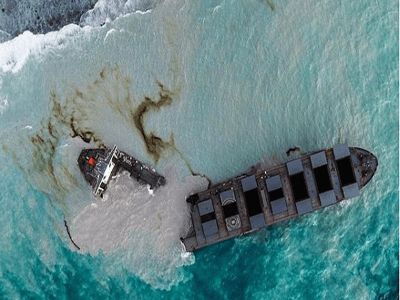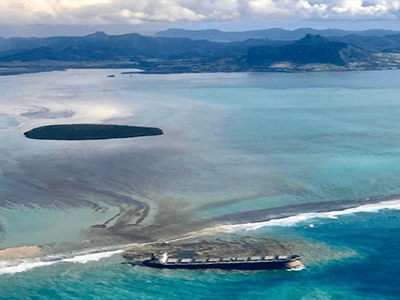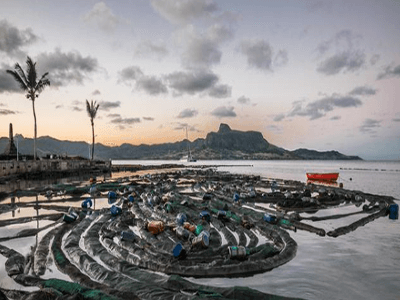Methods to clean up oil spill in Mauritius
Oil spill specific situation
On the evening of July 25, local time, the Japanese bulk carrier Wakashio, flying the Panamanian flag, 300 meters long and 50 meters wide, and carrying more than 3,800 tons of fuel, ran aground on the reef of Cape Esni in the southeastern waters of Mauritius. On August 6, local time, Wakashio leaked thousands of tons of fuel, polluting a large area of the sea. On August 15, local time, the ship broke into two pieces.
At the moment, in parallel with the oil pollution clean-up work, there is also an investigation of the accident.
According to news reports, on August 18, local time, after being questioned by the Central Criminal Investigation Department of Mauritius, the 58-year-old Indian captain Sunil Kumar Nandeshwar and his first officer Tilak Ratna Suboda were suspected of violating the 2011 Pirate Sea. Article 5 of the Commercial Law “Endangering the safe navigation of ships” were arrested, and the two appeared in court in the capital Port Louis on the same afternoon.
Point 1: Cause of the oil spill accident
Crew changes course to get WiFi signal
Splash247 reported that before the accident happened, local authorities in Mauritius had been trying to contact the cargo ship to warn it was on the wrong route. But it was precisely because the crew was celebrating their birthday that they missed the first few emergency calls because the captain was not in the cockpit.
Point 2: Oil spill cleaning up
Mauritius faces the worst ecological catastrophe in history
” Wakashio ” was loaded with about 200 tons of diesel oil and 3,800 tons of marine fuel oil. After it ran aground on a rock, a fuel tank containing 1,000 tons of fuel ruptured and polluted a large area of the sea.
Many scientists said that the oil spill was the worst ecological catastrophe in Mauritius’ history. Greenpeace Africa warned that thousands of species “are in danger of being submerged in the polluted ocean” and that such a situation “will have terrible consequences for Mauritius’ economy, food security, and people’s health.”
At present, volunteers from different regions are stepping up to deal with the oil spill together with the locals, and seabirds soaked in fuel can already be seen on the coast, and the dead fish are floating on the water. Experts say that cleaning up oil spill contamination is an extremely time-consuming task that needs to be carried out with great care.
Point 3: Oil spill handling methods
There are different methodologies that can be adopted for the purpose of cleaning up oil spills. Some of the few important and commonly used methods can be explained as follows:
1.Using oil containment boom
Using Oil containment Booms is for enclosing the oil floating on the water surface. While preventing it from spreading, it is towed by a boat to gather it so as to facilitate the recovery and reuse of the subsequent oil spill. The oil containment law has a wide range of applications, but it is greatly affected by weather factors, low visibility, and other poor weather conditions that will restrict the smooth progress of oil removal. However, using Oil Booms can replace the secondary impact of oil removal operations on the marine ecological environment.
2.Using Dispersants
The dispersant method is the most commonly used method in marine oil spills. Its principle is to reduce the face tension of oil/water, transform the power of ocean waves, and disperse the oil spilled into pieces under the action of seawater fluctuations and turbulence. Small particles are replaced in the entire water body.
3.Bioremediation
The goal of biodegradation is to increase the rate of decomposition of petroleum hydrocarbons by microorganisms in the ocean. There are three main limiting factors for the decomposition rate: 1. The number of oleophilic microorganisms; 2. The supply of nitrogen and phosphorus nutrients; 3. Oxygen supply to aerobic petroleum decomposition bacteria.
According to the above factors, the specific operation of the biodegradation method can be divided into two ways. One way is to use the oleophilic microorganisms that exist in the ocean to supply nutrients and oxygen; the other way is to supply nutrients and oxygen. Under conditions, a large number of oleophilic microorganisms are absorbed into the sea.
Compared with cleaning measures that can only deal with oil spills floating on the sea surface, biodegradation methods can deal with oil spills in the deep sea, and its replacement is smaller than chemical methods such as dispersants.
However, the biodegradation method is not without its drawbacks. Bacteriophage microorganisms take a long time to degrade oil, and they are only good at dealing with thin oil layers. At the same time, the intake of large amounts of nutrients into water bodies may cause harm to some marine organisms, and may even cause eutrophication of water bodies.
Oil spill strain
In actual oil spill accidents, the remedial measures taken will usually comprehensively evaluate the actual situation to select the most appropriate method. However, oil spill effects are still serious, long-term, and unpredictable. Therefore, taking into account the remedial measures after the oil spill, it is more important to prevent leakage before it occurs!




